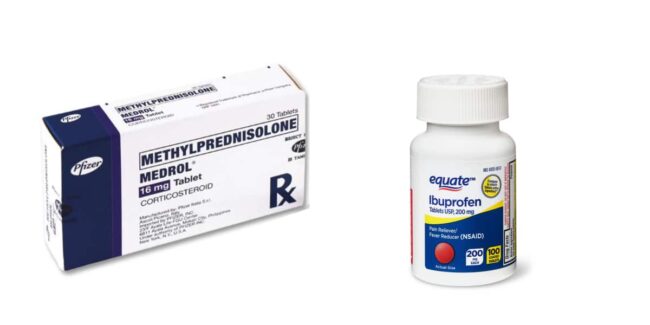Navigating the medical intricacies of drug interactions can be challenging, which is why it’s crucial to understand the dynamics between methylprednisolone and ibuprofen. This article aims to shed light on this topic, focusing on safety guidelines and potential side effects. In this comprehensive guide, you’ll find detailed insights on methylprednisolone and ibuprofen, their usages, potential side effects, and recommended dosages, among other essential aspects.
Table Of Contents
−- Wait Time Between Methylprednisolone and Ibuprofen
- Risk of Gastrointestinal Side Effects
- Drug Persistence and Half-life
- Doctor’s Guidance is Crucial
- What is Methylprednisolone?
- Mode of Action
- Availability and Cost
- Additional Forms
- Methylprednisolone Side Effects
- Methylprednisolone Dosage for Adults
- Methylprednisolone Dosage for Children
Wait Time Between Methylprednisolone and Ibuprofen
If you’ve completed a course of methylprednisolone, it’s generally advised to wait at least 6 to 8 hours before taking Advil or Aleve (naproxen). The reason for this precaution lies in the potential for aggravating gastrointestinal (GI) side effects when both medications are used in tandem.

Risk of Gastrointestinal Side Effects
Both medications, when used for an extended period, come with an increased likelihood of developing gastrointestinal issues such as nausea, cramps, and more severe complications. Short-term use may pose only a slight increase in these risks. Therefore, a well-calibrated approach to dosage and timing can mitigate these adverse effects.
Drug Persistence and Half-life
Understanding the half-life of a drug is pivotal for safe medication practices. The half-life of methylprednisolone ranges from 18 to 36 hours, and it may take 4 to 7 days for it to be completely eliminated from your system. The risk of developing additive gastrointestinal side effects decreases significantly a few hours after you’ve taken your last dose.
Doctor’s Guidance is Crucial
Should you find it absolutely necessary to take both medications, consult your healthcare provider. If your physician gives the nod for concurrent usage, it’s generally safe for short periods. Taking the medications with food can further help in reducing potential side effects.
What is Methylprednisolone?
Methylprednisolone serves as a potent remedy for numerous inflammatory conditions. Ranging from asthma, arthritis, and lupus to issues involving your blood, skin, and kidneys, this corticosteroid medication has a wide range of applications.
Mode of Action
As a corticosteroid, methylprednisolone works by dampening the immune response. It minimizes symptoms like itching, redness, and allergic reactions, bringing considerable relief to the afflicted parts of the body.
Availability and Cost
The medication is available both under its generic name and as the brand-name drug Medrol. Generic versions usually come at a lower price point but may vary in terms of dosage and strength.
Additional Forms
Besides oral tablets, methylprednisolone also comes in solution or suspension forms, which healthcare providers may administer directly.
Methylprednisolone Side Effects
While methylprednisolone generally doesn’t cause drowsiness, it’s essential to be mindful of its other potential side effects.
Common Side Effects
The more common issues include muscle weakness, weight gain, headaches, and skin issues such as acne. Psychological symptoms like confusion and depression, as well as physical conditions like elevated blood pressure, may also occur.
Handling Mild Side Effects
Mild side effects often subside on their own within a week or two. However, if they persist or worsen, a consultation with your healthcare provider is advised.
Methylprednisolone Dosage for Adults
For adults, the medication is primarily used to treat inflammatory diseases like rheumatoid arthritis, asthma, and severe allergies. However, not everyone can safely use this drug.
Medical Considerations
If you have conditions such as renal disease, heart issues, high blood pressure, or diabetes, among others, consult your physician about possible contraindications.
Dosage Chart
| Indication | Starting Dosage | Standard Dosage | Maximum Dosage |
| Asthma | 7.5-60 mg taken 1-4 times daily | 7.5-60 mg taken 1-4 times daily | 7.5-60 mg taken 1-4 times daily |
| Corticosteroid-responsive conditions | 4-48 mg per day | 4-48 mg per day | 4-48 mg per day |
| Gout | 24 mg per day | 4 mg per day | 24 mg per day |
| Multiple Sclerosis | 500-100 mg per day | 500-100 mg per day | 1000 mg per day |
Methylprednisolone Dosage for Children
Methylprednisolone is safe for children aged two years and older, as long as it is prescribed by a healthcare provider.
Dosage Based on Weight
The dosage for children is calculated based on their weight. The standard dosage for children 2 years and older is between 0.25-2 mg taken 1-4 times per day with meals. The maximum daily dosage should not exceed 60 mg.

Editorial Staff
Our writers, editors, content managers, and SEO specialist. We all take part in crafting amazing articles. We spend hours ensuring that each article is based on facts, researched, and thorough. You'll never want to click the back button to look for more answers other than here!
